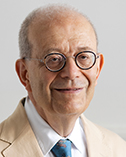
Jean-Michel Bismut
Universite Paris-Saclay
|
Primary Section: 11, Mathematics Membership Type:
International Member
(elected 2021)
|
Biosketch
Jean-Michel Bismut is a mathematician interested in the interplay between probability theory, analysis and differential geometry. His work includes the stochastic calculus of variations, refined local versions of the Atiyah-Singer index theorem, eta invariants, analytic torsion, and Quillen metrics. More recently, he developed the theory of the hypoelliptic Laplacian, a family of operators that interpolates between the standard Laplacian and the geodesic flow. Jean-Michel Bismut was born in Lisbon (Portugal). He graduated from Ecole Polytechnique (Paris) in 1970, and received his PhD in mathematics in 1973 from Université Paris VI. He joined the department of Mathematics at Université Paris-Sud (now Université Paris-Saclay) in 1981. He was one of the managing Editors of the journal Inventiones Mathematicae from 2002 to 2012. Jean-Michel Bismut has been a vice- president of International Mathematical Union from 2002 to 2006. He is a member of the Académie des Sciences, of Academia Europaea, and of the German National Academy Leopoldina.
Research Interests
I have been interested in probability theory, in the Atiyah-Singer index theory and its local refinements, with applications to eta invariants and to real and complex analytic torsion. With Gillet, Lebeau, and Soulé, I participated to the proof of a Riemann-Roch-Grothendieck theorem in Arakelov geometry. With Cheeger, I also worked on adiabatic limits of eta invariants, with Zhang, I gave another proof of the Ray-Singer conjecture on real analytic torsion, and with Lott, I proved an index theorem for flat vector bundles. My more recent work has been devoted to the hypoelliptic Laplacian, a deformation of the classical Laplacian to the generator of the geodesic flow, that Lebeau and myself developed the theory of, with applications to real analytic torsion, to the explicit geometric evaluation of semisimple orbital integrals, and to the proof of a Riemann-Roch-Grothendieck theorem in complex geometry. Probabilistic considerations, various versions of the Dirac operator, as well as Quillen's superconnections have been a constant theme of my work.

